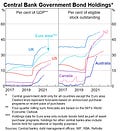The 2021 Budget is largely seen as putting an end to the politics of ‘debt and deficit,’ a narrative that defined good government in terms of driving the federal budget back into surplus. In the cont…
© 2024 Stephen Kirchner
Substack is the home for great culture

